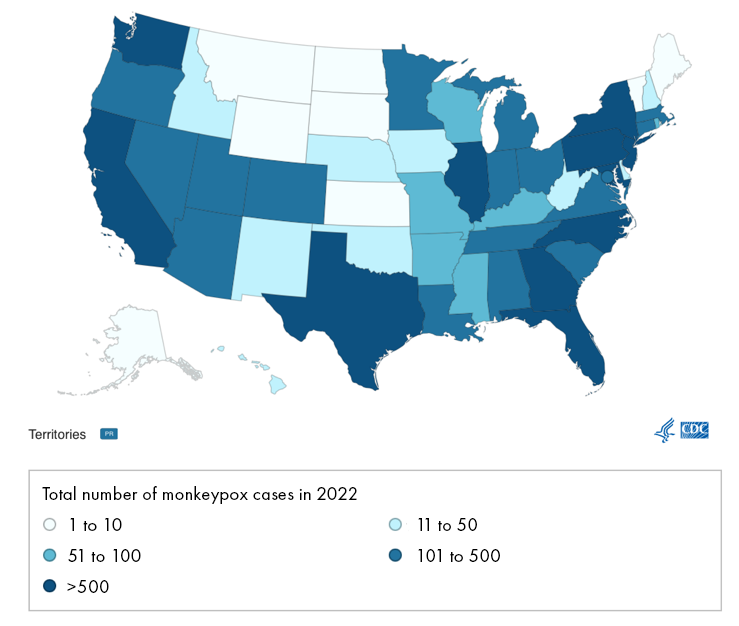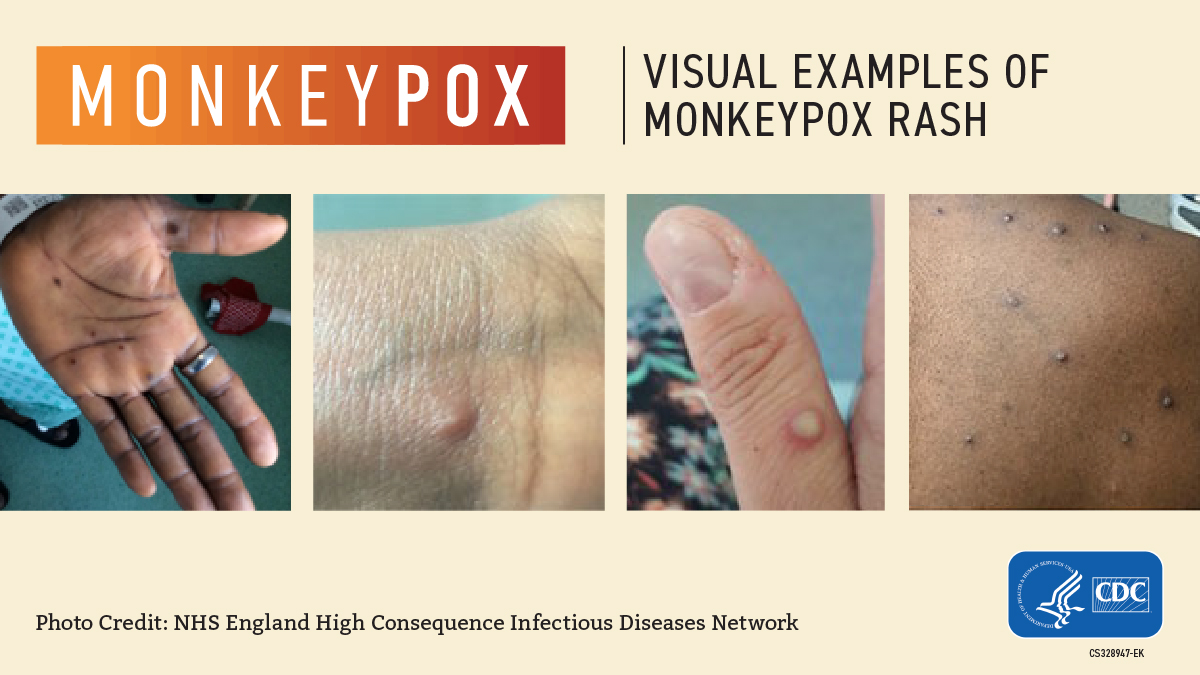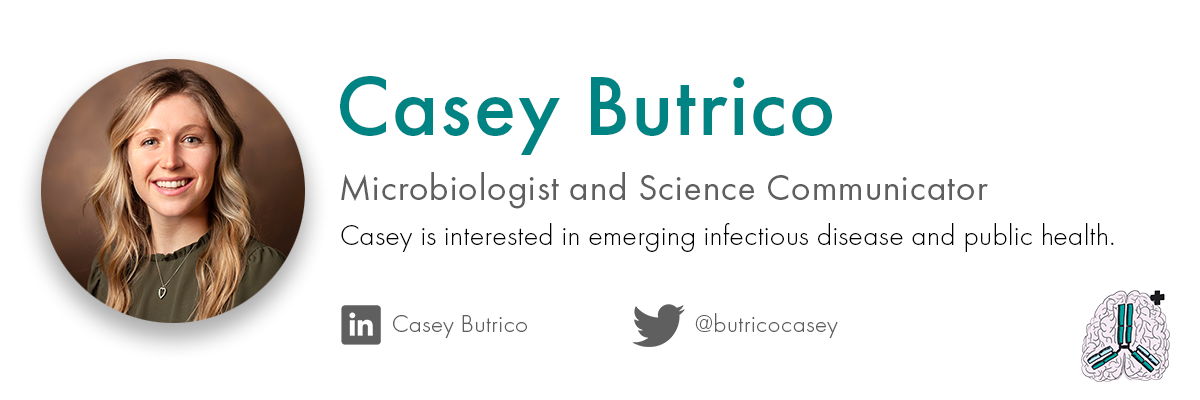Monkeypox – symptoms, transmission, and prevention
Since the 1970s, there has been a steady rise in monkeypox virus cases. While the Orthopoxvirus genus is no stranger to the United States, the specific virus responsible for the monkeypox outbreak has largely been found in African countries, until recently. The geographic footprint of the virus and age of those contracting the disease has steadily expanded. While the epidemiology and symptoms associated with monkeypox are complex, the Centers for Disease Control (CDC) and World Health Organization (WHO) have multiple resources to educate us on the disease progression and modes of transmission.
Monkeypox is not a novel virus.
Human monkeypox was first identified in the Democratic Republic of Congo (DRC) in 1970. Over the next three decades, the majority of monkeypox cases were reported in rural regions of the Democratic Republic of the Congo and west and central Africa. The virus primarily presented in children under ten years of age and occurred via transmission from animals (such as rats, prairie dogs, and monkeys) to humans. In the 1990s and early 2000s, a handful of small outbreaks were reported in the United States and were linked to imports or travel from African countries.
Monkeypox is spreading in the United States.
The 2022 monkeypox outbreak is distinct from the outbreaks in the late 1900s, as adults are primarily contracting the virus. Additionally, human-to-human transmission is responsible for the spread, while this type of transmission was previously rare. This could be due, in part, to the high mutational load of the monkeypox virus circulating, compared to the closest variant sequenced. In June 2022, the median age of infected individuals was around 38 years old, and as of September 2022, there were 25,341 confirmed cases of monkeypox in the United States. As monkeypox continues to spread, awareness of symptoms, treatment, and ongoing research can better prepare us to combat this virus.
Monkeypox symptoms progress through two phases.
Monkeypox frequently presents with symptoms that may be misconstrued as a sexually transmitted disease or, during early disease, the flu or chickenpox. According to the World Health Organization (WHO), monkeypox symptoms can be divided into an invasion period and a phase of rash eruption. The invasion period lasts up to five days and may include muscle aches, headache, and lymphadenopathy, or swelling of the lymph nodes. The rash typically appears one to three days after fever and tends to be concentrated on the face, hands and feet, oral mucous membranes, and genitalia.

Adapted from the Centers for Disease Control

Skin lesions are a defining symptom of monkeypox infection.
Monkeypox lesions progress through different structures over the course of disease, and the number of pustules/vesicles can span in number from a few to thousands. Symptoms typically last two to four weeks, and individuals with lesions remain contagious until they resolve. Understanding the symptoms and progression of the monkeypox virus will inform public and personal health measures to curb the spread of this emerging disease in the United States.
Monkeypox is spreading in the United States.
The 2022 monkeypox outbreak is distinct from the outbreaks in the late 1900s, as adults are primarily contracting the virus. Additionally, human-to-human transmission is responsible for the spread, while this type of transmission was previously rare. This could be due, in part, to the high mutational load of the monkeypox virus circulating, compared to the closest variant sequenced. In June 2022, the median age of infected individuals was around 38 years old, and as of September 2022, there were 25,341 confirmed cases of monkeypox in the United States. As monkeypox continues to spread, awareness of symptoms, treatment, and ongoing research can better prepare us to combat this virus.

Adapted from the Centers for Disease Control
Monkeypox symptoms progress through two phases.
Monkeypox frequently presents with symptoms that may be misconstrued as a sexually transmitted disease or, during early disease, the flu or chickenpox. According to the World Health Organization (WHO), monkeypox symptoms can be divided into an invasion period and a phase of rash eruption. The invasion period lasts up to five days and may include muscle aches, headache, and lymphadenopathy, or swelling of the lymph nodes. The rash typically appears one to three days after fever and tends to be concentrated on the face, hands and feet, oral mucous membranes, and genitalia.
Skin lesions are a defining symptom of monkeypox infection.
Monkeypox lesions progress through different structures over the course of disease, and the number of pustules/vesicles can span in number from a few to thousands. Symptoms typically last two to four weeks, and individuals with lesions remain contagious until they resolve. Understanding the symptoms and progression of the monkeypox virus will inform public and personal health measures to curb the spread of this emerging disease in the United States.

Monkeypox is contracted through skin-to-skin contact.
According the CDC, the primary method to prevent contracting monkeypox is to avoid close contact with individuals exhibiting a monkeypox-like rash as well as objects and materials used by those diagnosed with the disease. You are unlikely to contract monkeypox on the street, in the grocery store, or taking public transportation. However, certain situations where skin to skin contact occurs, such as saunas, clubs, and raves where minimal clothing is worn, may increase your chances of exposure. “It’s important to recognize that monkeypox is not a sexually transmitted infection, though it certainly can be transmitted through close skin-to-skin contact,” comments Dr. Buddy Creech, infectious disease physician and Director of the Vanderbilt Vaccine Research Program at Vanderbilt University Medical Center. Monkeypox can spread through respiratory secretions from extended face to face contact and, more commonly, via kissing, hugging, sex, and sharing sheets/towels. Approximately 90-95% of diagnosed individuals believe they contracted the virus through a sexual encounter.
There are steps we can take to protect ourselves against monkeypox.
The CDC has a number of recommendations for practicing safe sex if you or your partner develops monkeypox symptoms. Due to the zoonotic origin of the monkeypox virus, it is possible for humans to transmit the virus to animals including domestic dogs, cats, and rodents. Decontamination of surfaces, particularly porous materials such as bedding, can minimize disease spread within a household. One study found that 60% (6/10) of porous surfaces and 5% (1/21) of nonporous surfaces harbored live virus 15 days after a monkeypox patient occupied a house. EPA-registered disinfectants and laundry detergents are efficacious for decontamination. Specific concentrations and exposure times of disinfectants are highlighted the comprehensive review by Kampf. Understanding the symptom progression, primary modes of transmission, and best practices for protecting ourselves against the monkeypox virus power us to fight the spread of the disease.

